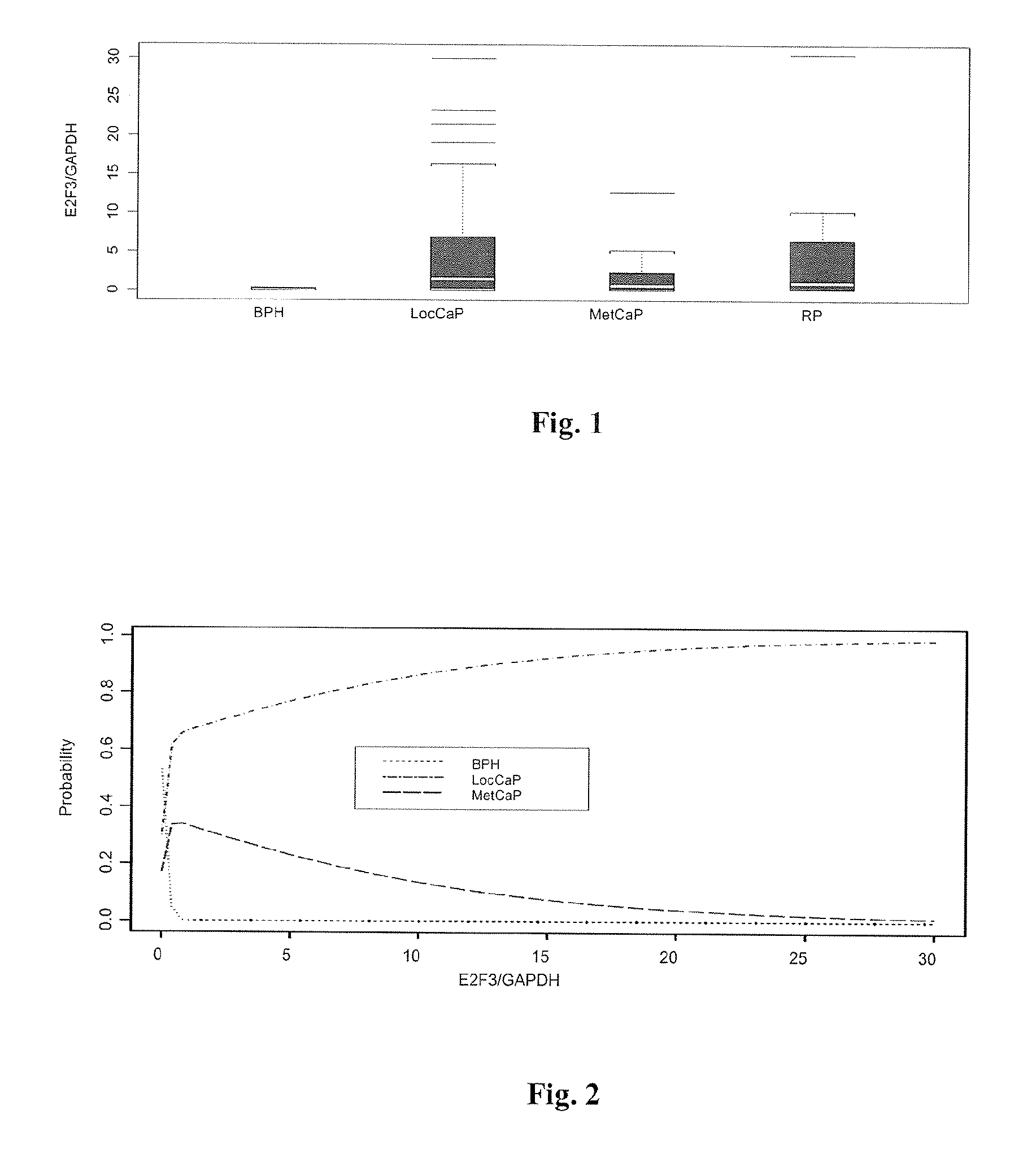Diagnosis of prostate cancer
- Summary
- Abstract
- Description
- Claims
- Application Information
AI Technical Summary
Benefits of technology
Problems solved by technology
Method used
Image
Examples
example 1
E2F3 as a Cap Marker
Materials and Methods
Patient Recruitment
[0155]Patients attending the Uro-oncology clinic at St. George's Hospital (London, UK) were recruited on the basis of diagnosis by prostate biopsies and transurethral resection of the prostate (TURP). Blood samples were obtained following fully informed consent. The research was carried out in accordance with declaration of Helsinki (2000) of the World Medical Association. Ethical approval for this study was obtained from the Wandsworth Local Research Ethics Committee.
[0156]Patients were classified into distinct groups based on clinical diagnosis and histopathological information as well as radiological information (bone scans and CT / MRI scans). Gleason scores for each patient were available. Gleason score, the most commonly used CaP grading system, involves the assignment of numbers to cancerous prostate tissue, ranging from 1 to 5, based on how much the arrangement of cancer cells mimics the way normal prostate cells form...
example 2
HIF-1α as a Marker for CAP
Methods
[0179]Patients attending the Uro-oncology clinic at St. George's Hospital (London, UK) were recruited on the basis of diagnosis by prostate biopsy.
[0180]Total RNA was extracted in quadruplet from blood taken from 164 patients and 10 normal male control individuals (RNAzol method—Biogenesis) and was reversed transcribed into first-strand cDNA using SuperScript™ II preamplification system with an oligo(dT)12-18 primer mixture (Invitrogen).
[0181]Patients were classified into four distinct groups based on clinical diagnosis and histopathological information as well as radiological information (bone scans and CT / MRI scans): No Evidence of Malignancy (NEOM, N=36) also including patients diagnosed with BPH; localised CaP (LocCaP, N=67); metastatic CaP (MetCaP; N=27) and post-operatively obtained blood samples from patients who had undergone radical prostatectomy (RP, N=34).
[0182]HIF-1α gene expression was analysed in blood samples of CaP patients by qRT-PCR...
example 3
CAXII as a Marker for CAP
[0192]qRT-PCR Results
[0193]All patient samples were positive for CAXII expression. Variations in signal intensity indicated differences in the actual levels of the enzyme among patients. Quantitative RT-PCR showed that:[0194]CAXII expression is up-regulated in the localised cancer group (LCaP) (6-fold) compared to the benign prostatic hyperplasia (BPH) group; and[0195]down-regulated in the MCaP (metastatic cancer) group (the majority being hormone-refractory) (18-fold), compared to the LCaP group.
TABLE 2Summary of CAXII qRT-PCR ResultsRT-PCR: positive expressionBPHLCaPMCaPMale controls5 / 766 / 7031 / 350qRT-PCR: mean expression levelsn = 10n = 8n = 18118.5703.940.1
CONCLUSION
[0196]CAXII is hypoxia-induced (via HIF-1) and so the results indicate that hypoxia is a mechanism involved in CaP development. However, down-regulation of CAXII in the MCaP patients indicates a possible alternative pathway that overrides the hypoxia-induced mechanism in hormone-refractory end...
PUM
| Property | Measurement | Unit |
|---|---|---|
| Fraction | aaaaa | aaaaa |
| Fraction | aaaaa | aaaaa |
| Fraction | aaaaa | aaaaa |
Abstract
Description
Claims
Application Information
 Login to View More
Login to View More - R&D
- Intellectual Property
- Life Sciences
- Materials
- Tech Scout
- Unparalleled Data Quality
- Higher Quality Content
- 60% Fewer Hallucinations
Browse by: Latest US Patents, China's latest patents, Technical Efficacy Thesaurus, Application Domain, Technology Topic, Popular Technical Reports.
© 2025 PatSnap. All rights reserved.Legal|Privacy policy|Modern Slavery Act Transparency Statement|Sitemap|About US| Contact US: help@patsnap.com



